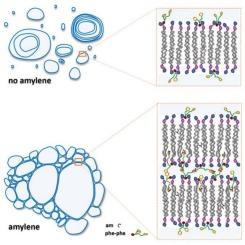二肽介导的磷脂囊泡完整性和聚集的影响
IF 5.2
2区 化学
Q2 CHEMISTRY, PHYSICAL
引用次数: 0
摘要
脂质膜之间的相互作用是生物、生化和生物物理过程的核心。虽然完整囊泡之间的粘附通常需要复杂的分子连接物来克服静电和水合排斥,但聚集涉及双层破坏和囊泡完整性的丧失,这一现象通常与病理有关。在这里,我们报道了一种通过二苯丙氨酸(Phe-Phe)(阿尔茨海默病β-淀粉样肽的二肽基序)和丙烯(一种用作氯甲烷稳定剂的小极性烯烃)的联合作用诱导两性离子囊泡聚集的最小和直接的途径。利用核磁共振波谱、显微镜、热力学和纳米力学表征,我们证明了Phe-Phe单独对双分子层组织的干扰只是轻微的,但在丙烯的存在下,它会协同驱动膜破坏和囊泡聚集。这些结果强调了小分子的相互作用如何重组两性离子膜并最终诱导自发聚集。本文章由计算机程序翻译,如有差异,请以英文原文为准。

Impact of amylenes in dipeptide-mediated phospholipid vesicle integrity and aggregation
Interactions between lipid membranes are central to biological, biochemical, and biophysical processes. While adhesion between intact vesicles typically requires complex molecular linkers to overcome electrostatic and hydration repulsions, aggregation involves bilayer disruption and loss of vesicle integrity, a phenomenon more often associated with pathology. Here we report a minimal and straightforward route to induce aggregation of zwitterionic vesicles through the combined action of diphenylalanine (Phe-Phe), a dipeptide motif of the Alzheimer's β-amyloid peptide, and amylene, a small apolar alkene used as a chloroform stabilizer. Using NMR spectroscopy, microscopy, and thermodynamic and nanomechanical characterization, we demonstrate that Phe-Phe alone perturbs bilayer organization only mildly, but in the presence of amylene it synergistically drives membrane disruption and vesicle aggregation. These results highlight how the interplay of small molecules can reorganize zwitterionic membranes and eventually induce spontaneous aggregation.
求助全文
通过发布文献求助,成功后即可免费获取论文全文。
去求助
来源期刊

Journal of Molecular Liquids
化学-物理:原子、分子和化学物理
CiteScore
10.30
自引率
16.70%
发文量
2597
审稿时长
78 days
期刊介绍:
The journal includes papers in the following areas:
– Simple organic liquids and mixtures
– Ionic liquids
– Surfactant solutions (including micelles and vesicles) and liquid interfaces
– Colloidal solutions and nanoparticles
– Thermotropic and lyotropic liquid crystals
– Ferrofluids
– Water, aqueous solutions and other hydrogen-bonded liquids
– Lubricants, polymer solutions and melts
– Molten metals and salts
– Phase transitions and critical phenomena in liquids and confined fluids
– Self assembly in complex liquids.– Biomolecules in solution
The emphasis is on the molecular (or microscopic) understanding of particular liquids or liquid systems, especially concerning structure, dynamics and intermolecular forces. The experimental techniques used may include:
– Conventional spectroscopy (mid-IR and far-IR, Raman, NMR, etc.)
– Non-linear optics and time resolved spectroscopy (psec, fsec, asec, ISRS, etc.)
– Light scattering (Rayleigh, Brillouin, PCS, etc.)
– Dielectric relaxation
– X-ray and neutron scattering and diffraction.
Experimental studies, computer simulations (MD or MC) and analytical theory will be considered for publication; papers just reporting experimental results that do not contribute to the understanding of the fundamentals of molecular and ionic liquids will not be accepted. Only papers of a non-routine nature and advancing the field will be considered for publication.
 求助内容:
求助内容: 应助结果提醒方式:
应助结果提醒方式:


